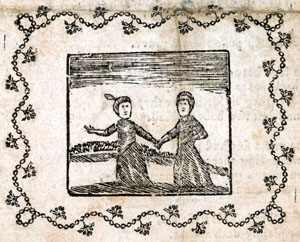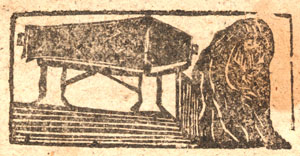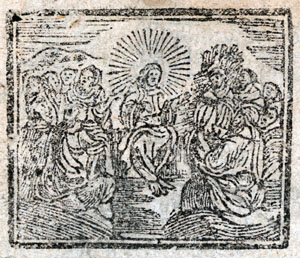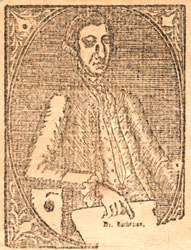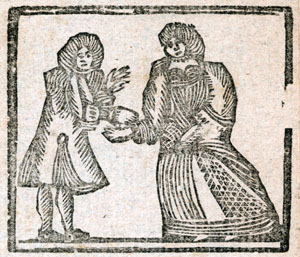
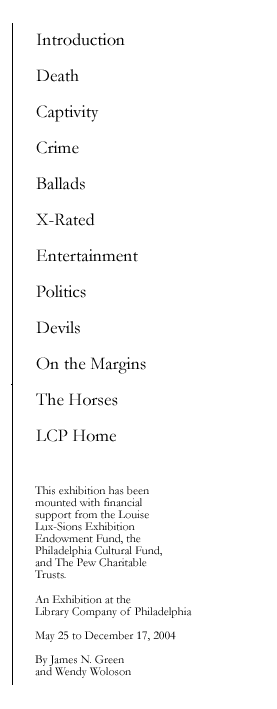
The ballad— a story told in verse— is one of the oldest forms of popular entertainment. Long before the invention of printing, ballads were transmitted from person to person as they were sung. Printed ballads were sold by itinerant hawkers in town and county, who sang the ballads they sold, thus providing the tune even as they displayed their wares. Many early American ballads were copies of Englishballads printed asearly as the 16 th century. They provide one of the oldest examples of the commercialization of popular culture.
The Two Babes in the Wood. New York: Printed for the United Company of Flying Stationers, [ca. 1795?].
This old English ballad was reprinted at least 18 times in America before 1800, sometimes as a broadside but more often as a chapbook like this one. It also appeared in a prose version, with the same story: A dying man asks his brother to care for his two children; the evil uncle has them murdered in the woods by two thieves so he can seize their inheritance; he seems to get away with it, but then his crops fail mysteriously, his own children die, he is arrested for debt, and he dies miserably in prison.
The Bride’s Burial. [U.S., ca. 1770].
It seems the very act of getting married killed this bride: they had just tied the knot when “a chilling Cold [did] … seize on my True Love’s Heart. Down in a Swoon she fell, as cold as any Stone.” This ballad was first licensed in London in 1603. Several American printings survive, all of them in only one copy. The woodcut of coffin and mourner is also otherwise unknown.
A Dialogue between Death and a Lady. [U.S., ca. 1790].
Ten early American printings of this old English ballad are known, two of them pamphlets including “The Bride’s Burial.” A haughty rich young lady tries to buy off Death when he comes to claim her, but Death shows “no respect.”
A Dying Hymn, on the death of Miss Polly Gould. And The Last Words of Polly Goold. Two editions, both [U.S. ca. 1790?].
Nine different American printings of this ballad are known, and three of them are in the Zinman Collection, all unique copies. It is the forerunner of innumerable idealized death-bed scenes of pious children in the 19th century, but here sentimentality was balanced by the robust language typical of the 18th-century ballad. see image below
The Major’s Only Son, and his True Love’s overthrow. [U.S., ca. 1790].
In this ballad the Major will not permit his son to marry his true love because her family is poor; her parents are offended because they think they are just as good, so they forbid the marriage too. The young lady died a pathetic death, and Major’s son did “distracted run, and so forever was undone.” This ballad was printed seven times in America in the 1790s, and most versions are known in only one copy.
The Fortunate Lovers: or, Sweet William of Plymouth. [Massachusetts, ca. 1780?].
Another tale of greedy parents forbidding their daughter to marry a poor man. Everyone deceives everyone else but by sheer chance the lovers are reunited at last.
The Damsel’s Tragedy; or the Cruel Mother-in-Law. Salem: Printed [by N. & J. Coverly] at the sign of Faust’s Statue, where cash and the highest price is given for cotton and linen rags, [1799?].
Yet another tale of a cruel mother forbidding her son to marry a poor woman. This mother’s cruelty is exceptional. As she plunges her knife into the poor girl’s heart, she cries, “you must endure, instead of Cupid’s dart, one fatal minute’s smart.” Her son learns of the murder from his lover’s ghost, who appears to him “from head to foot besmear’, in purple gore.” He commits suicide and the aghast mother stabs herself. The imprint suggests the itinerants who sold such ballads also gathered rags used for making paper.
The Doctor and Squire: an excellent new song. [Boston]: Sold [by E. Russell] next the Stump of Liberty-Tree, 1792, where Country Shopkeepers, Travelling-Traders, and others may be supplied.
The clever Doctor helps the Squire trick his scornful Lady into showing her true feelings, and her parents relent when they see he is “a young Man of a politic wit.” The “Travelling-Traders” who sold this rollicking song no doubt also taught the “pleasant New Tune” to their customers. The song came from England, but the woodcut is by Paul Revere, a copy of a portrait of John Dickinson engraved in Philadelphia, and oddly reused. This is the only known copy. see image below
Adam and Eve. A favourite New Song, very much in vogue. [Boston, 1797?].
This song bases traditional gender roles on physiology: Because Eve did not emerge from Adam’s head, “she must not rule him.” Nor did she come from his feet, so “he must not abuse her.” Instead she was made from his rib, “abstracted from near to Adam’s heart,” so he must love her always. This song was in vogue in Boston in 1797, as we know from two other printings. see image below

